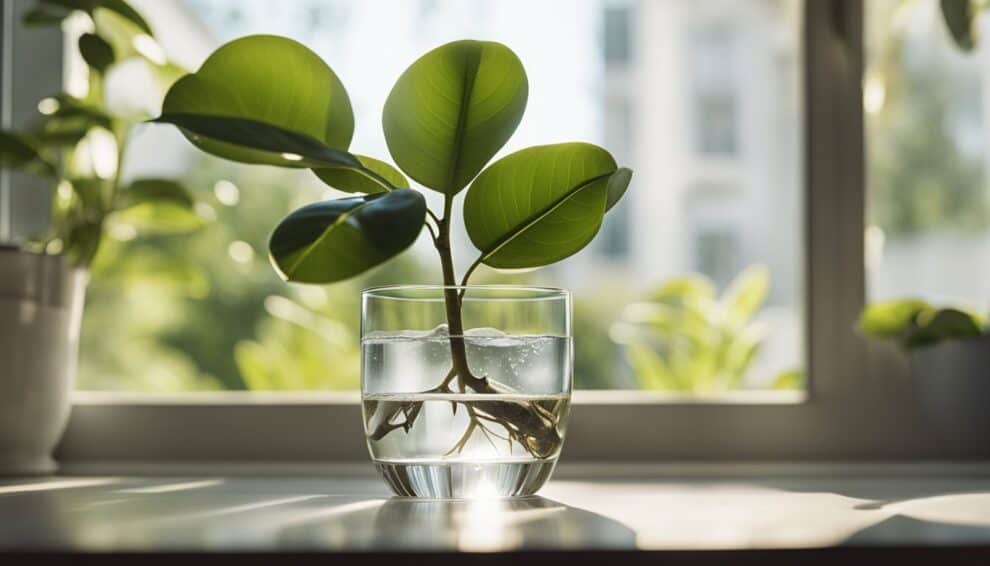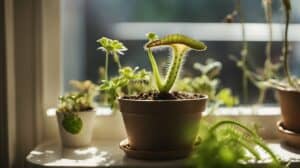Rubber plants, also known as Ficus elastica, are a popular choice for indoor plants due to their attractive foliage and ease of care.
These plants are native to the tropical regions of India and Malaysia and can grow up to 100 feet tall in their natural habitat.
However, when grown indoors, they typically reach a height of 6-10 feet.

One of the most interesting aspects of rubber plants is their ability to be propagated.
Propagation is the process of creating new plants from existing ones, and it is a great way to expand your collection of rubber plants or share them with friends and family.
There are several methods of propagation, including air layering, stem cuttings, and leaf cuttings, each with its own advantages and disadvantages.
In this article, we will explore these different methods and provide tips for successful rubber plant propagation.
Understanding Rubber Plant Propagation
Benefits of Propagating Ficus Elastica
There are several benefits of propagating Ficus Elastica, also known as the Rubber Plant.
Firstly, propagating your plant ensures that you have a constant supply of new plants to keep your garden looking beautiful.
Additionally, propagating your Rubber Plant allows you to experiment with different growing techniques and soil types to find the best fit for your plant.
Furthermore, propagating your Rubber Plant can be a fun and rewarding experience.
Watching the new growth sprout from your propagated plant can be a source of satisfaction and pride.
It can also be a great way to share your love for gardening with friends and family by gifting them a new plant.
Best Time for Propagation
The best time for propagating your Rubber Plant is in the spring or summer.
During these seasons, the plant is actively growing and producing new shoots, making it easier to propagate.
Before propagating your Rubber Plant, ensure that you have a healthy and mature plant to work with.
It is best to wait until your plant is at least two years old before attempting to propagate it.
To propagate your Rubber Plant, you can use stem cuttings or air layering techniques.
Stem cuttings involve taking a cutting from the stem of the plant and rooting it in soil or water.
Air layering involves creating a small wound on the stem of the plant and wrapping it in moist sphagnum moss until roots develop.
Overall, propagating your Rubber Plant is a great way to expand your garden and experiment with new growing techniques.
With the right care and attention, your propagated Rubber Plants can grow into healthy and beautiful additions to your garden.
Propagation Methods

Stem Cuttings in Water
One of the easiest ways to propagate a rubber plant is through stem cuttings in water.
To do this, simply cut a healthy stem from the parent plant and place it in a jar or vase filled with water.
Make sure to remove any leaves from the bottom of the stem that will be submerged in the water.
It’s important to change the water every few days to prevent bacteria growth and ensure the stem stays healthy.
After a few weeks, the cutting should start to grow roots and can be transplanted into soil.
Stem Cuttings in Soil
Another way to propagate a rubber plant is through stem cuttings in soil.
This method involves cutting a healthy stem from the parent plant and planting it directly into moist soil.
Make sure to remove any leaves from the bottom of the stem that will be buried in the soil.
It’s important to keep the soil moist but not waterlogged to prevent rotting.
After a few weeks, the cutting should start to grow roots and can be transplanted into a larger pot.
Air Layering Technique
The air layering technique is a more advanced method of propagation but can be very effective.
This method involves making a small incision in the stem of the parent plant and wrapping it with moist sphagnum moss and plastic wrap.
The moss should be kept moist and after a few weeks, roots should start to grow from the incision.
The stem can then be cut below the incision and transplanted into soil.
This method can take longer than stem cuttings but can result in a larger, more mature plant.
Post-Propagation Care

After propagating a rubber plant, it is essential to provide proper care to ensure its growth and survival.
This section covers the initial care for new cuttings and long-term growth tips.
Initial Care for New Cuttings
Newly propagated rubber plant cuttings require a specific environment to root successfully. Keep the following in mind when caring for new cuttings:
- Watering: Water the cuttings thoroughly after planting them in soil. Keep the soil moist but not waterlogged.
- Humidity: Maintain high humidity around the cuttings by covering them with a plastic bag or placing them in a humid environment, like a terrarium.
- Light: Provide bright, indirect light to the cuttings. Avoid direct sunlight, as it can scorch the leaves.
- Temperature: Keep the cuttings in a warm location with temperatures ranging between 65°F and 75°F.
Long-Term Growth Tips
Once the rubber plant cuttings have rooted and established themselves, they require different care. Here are some tips for long-term growth:
- Watering: Water the plant when the top inch of soil is dry. Do not overwater, as this can lead to root rot.
- Light: Provide bright, indirect light to the plant. Direct sunlight can scorch the leaves and cause damage.
- Fertilization: Fertilize the plant once a month during the growing season using a balanced fertilizer.
Do not fertilize during the winter months.
- Pruning: Prune the plant regularly to maintain its shape and promote growth. Remove any dead or yellowing leaves to prevent disease.
- Repotting: Repot the plant every two to three years to provide fresh soil and room for growth.
By following these tips for post-propagation care of a rubber plant, you can ensure its growth and longevity.
Frequently Asked Questions

What’s the best method to propagate a rubber plant cutting?
The best method to propagate a rubber plant cutting is by using stem cuttings.
Take a 4-6 inch cutting from the tip of a healthy stem and remove the lower leaves. Dip the cut end in rooting hormone and plant it in a well-draining soil mix.
Keep the soil moist and warm, and in a few weeks, you should see new growth.
Can you propagate a rubber plant using just a leaf?
No, you cannot propagate a rubber plant using just a leaf. The plant needs a stem cutting with at least one node to produce roots and new growth.
What are the steps for propagating a rubber plant in water?
To propagate a rubber plant in water, take a 4-6 inch cutting from the tip of a healthy stem and remove the lower leaves.
Place the cutting in a jar of water, making sure that the bottom of the stem is submerged.
Change the water every few days and keep the jar in a warm, bright location. In a few weeks, you should see roots starting to grow.
Once the roots are at least an inch long, you can transplant the cutting into soil.
How do you encourage root growth in rubber plant cuttings in soil?
To encourage root growth in rubber plant cuttings in soil, make sure that the soil mix is well-draining and moist.
Keep the cutting in a warm, bright location, and mist the leaves regularly to maintain humidity.
You can also cover the cutting with a plastic bag to create a mini greenhouse effect.
This will help to keep the cutting moist and warm, which will encourage root growth.
What care should be taken after propagating a rubber plant indoors?
After propagating a rubber plant indoors, make sure to keep the new plant in a warm, bright location with indirect sunlight.
Water the plant regularly, but do not overwater it. Wait until the top inch of soil is dry before watering.
You can also fertilize the plant with a balanced fertilizer every month during the growing season.
How do you successfully propagate the top of a rubber plant?
To successfully propagate the top of a rubber plant, take a stem cutting from the top of the plant, making sure that it has at least one node.
Remove the lower leaves and dip the cut end in rooting hormone. Plant the cutting in a well-draining soil mix and keep it moist and warm.
In a few weeks, you should see new growth.













